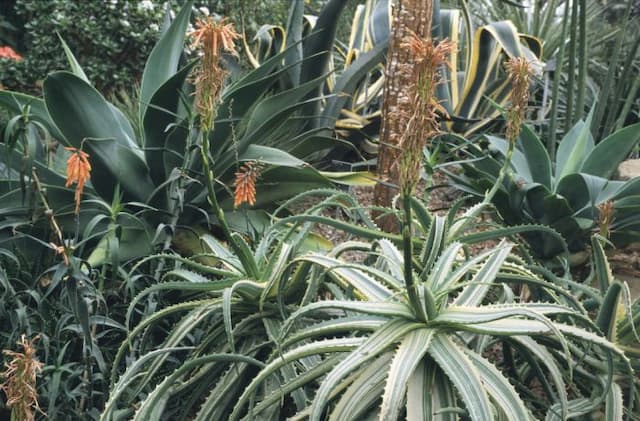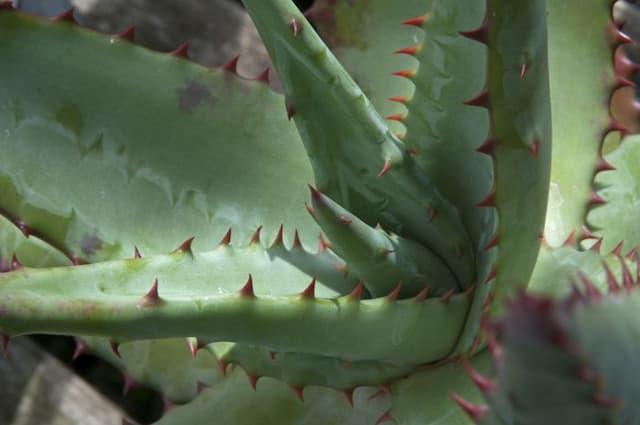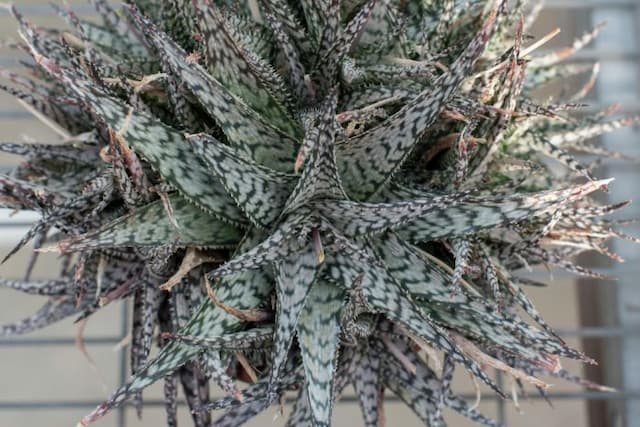Red Hot Poker Kniphofia 'Wrexham Buttercup'

ABOUT
Kniphofia 'Wrexham Buttercup', commonly known as Red Hot Poker or Torch Lily, is a striking perennial plant known for its unique flowering spikes. The plant forms a clump of grass-like, slightly arching, narrow green leaves which provide an attractive backdrop for the bloom spikes. The distinguishing feature of this cultivar is its vibrant flower spikes that emerge on upright stems above the foliage. These flower spikes boast a dense, cylindrical shape and are known for their gradient of color, typically starting with a creamy yellow hue at the top that transitions to a rich buttery yellow further down the spike. The blossoms are tubular and beloved by hummingbirds and other pollinators. The blooming period is often during the summer months, providing a showy, eye-catching display. The individual flowers on the spike bloom progressively from bottom to top, giving the plant a prolonged period of visual interest. After the flowers have finished, the spikes remain, adding structure to the garden until they are cut back. Red Hot Poker plants generally enjoy sunny locations and can be part of borders, rock gardens, or wildflower collections where their dramatic blossoms can truly stand out.
About this plant
 Names
NamesFamily
Asphodelaceae.
Synonyms
Red Hot Poker, Torch Lily, Poker Plant.
Common names
Kniphofia 'Wrexham Buttercup'.
 Toxicity
ToxicityTo humans
The Red Hot Poker (the most common common name for Kniphofia 'Wrexham Buttercup') typically is not considered highly toxic to humans. However, as with many garden plants, it may cause mild irritation or an allergic reaction if ingested or if the sap comes into contact with the skin or eyes. If ingested in large quantities, it might cause stomach upset or gastrointestinal discomfort. It's always advised to keep plants out of reach of small children who might chew on them.
To pets
Red Hot Poker is also not commonly known to be highly toxic to pets, such as dogs and cats. However, pets can have individual reactions or allergies. Ingestion can potentially lead to mild gastrointestinal upset, such as vomiting or diarrhea, especially if the pet eats a large amount. It is best to prevent pets from chewing on garden plants, including the Red Hot Poker.
 Characteristics
CharacteristicsLife cycle
Perennials
Foliage type
Evergreen
Color of leaves
Green
Flower color
Yellow
Height
3 feet (0.91 meters)
Spread
2 feet (0.61 meters)
Plant type
Herb
Hardiness zones
6
Native area
South Africa
Benefits
 General Benefits
General Benefits- Attracts pollinators: Kniphofia 'Wrexham Buttercup', commonly known as Red Hot Poker, is attractive to bees, butterflies, and other beneficial pollinators, enhancing biodiversity in the garden.
- Drought tolerance: Once established, the Red Hot Poker is drought-resistant, making it a good choice for xeriscaping and water-wise gardens.
- Long blooming period: The plant has a long flowering season, providing bright and vibrant colors from late spring to early fall.
- Low maintenance: Red Hot Poker is known for being easy to care for, requiring minimal pruning and upkeep once established.
- Deer resistance: The plant is not a preferred food source for deer, making it a good option for gardens in areas with high deer populations.
- Architectural interest: The tall, striking flowers and grass-like foliage of the Red Hot Poker add vertical interest and structure to garden beds and borders.
- Winter hardiness: This plant is capable of withstanding cold temperatures, making it suitable for a variety of climates.
 Medical Properties
Medical PropertiesThis plant is not used for medical purposes.
 Air-purifying Qualities
Air-purifying QualitiesThis plant is not specifically known for air purifying qualities.
 Other Uses
Other Uses- Artistic Inspiration: The striking tall spikes of Kniphofia 'Wrexham Buttercup', also known as Red Hot Poker, can inspire artists and be used as a subject for watercolor, oil painting, or photography projects.
- Floral Arrangements: Cut flowers of the Red Hot Poker can be used in bold, contemporary floral arrangements to add height and a splash of color to the design.
- Themed Gardens: Red Hot Poker can be planted in fire-themed gardens due to its fiery-colored blooms, complementing the red and orange hues of other plants to create a 'hot' visual display.
- Educational Tool: The distinct flowering pattern of the Red Hot Poker is useful for teaching botany and plant morphology, demonstrating inflorescence types to students.
- Markers for Boundaries: Due to their height and visibility, these plants can be used as natural markers for property boundaries or to delineate different areas in a large garden.
- Habitat Creation: When planted in gardens, Red Hot Poker can provide habitat and food for hummingbirds, bees, and butterflies, supporting biodiversity.
- Dye Production: The flowers and seeds might be used to produce natural dyes for coloring fabrics or other materials in shades of yellow or green.
- Seasonal Celebrations: The vibrant flowers can be incorporated into festive decorations for occasions such as summer solstice parties or garden events.
- Companion Planting: Red Hot Poker can be used in companion planting strategies; for example, planting them alongside vegetables to attract pollinators can potentially increase vegetable yields.
- Dramatic Landscape Focal Points: Red Hot Poker plants can serve as a dramatic focal point in landscape designs, particularly in rock gardens or xeriscapes where their height can contrast well with low-growing succulents and groundcovers.
Interesting Facts
 Feng Shui
Feng ShuiThe Red Hot Poker is not used in Feng Shui practice.
 Zodiac Sign Compitability
Zodiac Sign CompitabilityThe Red Hot Poker is not used in astrology practice.
 Plant Symbolism
Plant Symbolism- Vitality: The vibrant and torch-like flowers of the Red Hot Poker symbolize high energy and a lively spirit.
- Strength: Its sturdy and upright stems represent standing strong and resilient in the face of challenges.
- Attraction: The Red Hot Poker's striking appearance is associated with drawing attention and signifies the ability to captivate or allure.
 Water
WaterThe Red Hot Poker, or Kniphofia 'Wrexham Buttercup', requires consistent moisture, especially during its growing season in the spring and early summer. It's best to water this perennial deeply about once a week, allowing the soil to slightly dry out between watering sessions. During hot, dry spells, increase watering to twice a week. Supply the plant with approximately one inch of water each time, ensuring you're soaking the soil to reach the roots. In the absence of rainfall, a total of about 1 to 1.5 gallons per week is suitable for an established plant, adjusted based on temperature and soil conditions.
 Light
LightThe Red Hot Poker thrives in full sun and benefits from at least six hours of direct sunlight per day. It's ideal to plant it in a spot where it can soak up the morning sun and be protected from the intense late afternoon heat if possible. However, the plant is tolerant of heat and can still perform well in areas with full, all-day sunlight.
 Temperature
TemperatureRed Hot Pokers prefer a temperate climate and are hardy in USDA zones 5 through 9. They can withstand minimum temperatures down to about -20°F and are tolerant of high summer temperatures as well. The ideal temperature range for Kniphofia 'Wrexham Buttercup' is between 50°F and 75°F, which promotes healthy growth and flowering.
 Pruning
PruningPruning the Red Hot Poker helps to maintain a neat appearance and encourages more blooms. After the flower spikes have faded, cut them back to the base to promote a second bloom. In late fall or early winter, after the plant has finished blooming and the foliage begins to die back, prune the foliage to within a few inches of the ground. This annual tidy-up can help prevent disease and makes room for new growth in the spring.
 Cleaning
CleaningAs needed
 Soil
SoilRed Hot Poker thrives in well-draining, fertile soil with a pH between 6.0 and 7.0. A mix of loamy soil with compost and a bit of sand for improved drainage is optimal.
 Repotting
RepottingRed Hot Poker does not require frequent repotting and should only be divided or repotted if it becomes overcrowded, typically every 3-5 years.
 Humidity & Misting
Humidity & MistingRed Hot Poker tolerates a wide range of humidity levels but prefers moderate conditions; it does not require high humidity to thrive.
 Suitable locations
Suitable locationsIndoor
Ensure plenty of light; use well-draining soil mix.
Outdoor
Plant in full sun, well-draining soil; water deeply.
Hardiness zone
5-9 USDA
 Life cycle
Life cycleThe life cycle of Kniphofia 'Wrexham Buttercup', commonly known as Red Hot Poker or Torch Lily, starts with the germination of seeds or division of the rootstock in spring. Initially, it develops a basal clump of long, narrow leaves. As the plant matures, it develops tall, sturdy flower spikes that bloom from the bottom upwards, featuring tubular, yellow to buttery-yellow flowers which are attractive to hummingbirds and other pollinators. After blooming, which occurs from late spring to early summer, the flowers fade and seeds form, completing the reproductive cycle. During the fall, the foliage may die back, especially in colder climates. The plant then goes dormant over winter, with the rootstock surviving to regenerate the following spring.
 Propogation
PropogationPropogation time
Early Spring
The Kniphofia 'Wrexham Buttercup', commonly known as red hot poker, is typically propagated by division, which is the most popular method for this perennial. Division is best done in the spring as new growth begins, providing the plant with the full growing season to establish. To propagate by division, carefully dig up the clump and use a sharp knife or spade to separate the crowns, ensuring each division has a portion of the root system. Replant the divisions promptly, at the same depth they were originally growing, and water thoroughly. It’s important to provide adequate space for the new plants to grow, ideally about 18 inches (approximately 45 centimeters) apart, to allow for proper air circulation and growth.









